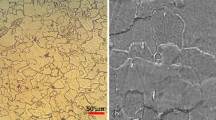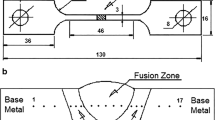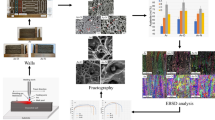Abstract
The primary objective of the present work is to evaluate the influence of various commercial gases on the microstructure of tubular AISI 304 austenitic stainless during welding. This was carried out using CO2, Ar, N2, Ar + 25%CO2 and Ar + 2%O2 gases, which are common inert gases or mixture specified in numerous technical standards associated with welding. These five gases were evaluated using flow rate range of 6–18 L/min. Different welding speeds, wire feed speeds, shield gases (Ar + 2% O2), distance nozzle contact pieces, voltages and currents were employed to validate the present observations. The microstructures of the samples were evaluated along the cross section of the face of the weld using optical microscopy. The samples were further analyzed by means of magnetic testing, which could provide information related to the evolution of ferrite. The estimated phase fractions were then compared to the predictions provided by the Welding Research Council (WRC-92) diagram. The optical microscopy images showed small microstructural variations between the samples with different gas purge conditions, even when using the maximum gas flow rate. However, these observations were inconsistent with the magnetic response of the material, which provided significant differences in the phase fractions between the face and the root of the weld. The discrepancies between these two methods were analyzed to evaluate the phases and consistently track the phase fractions after welding.

















Similar content being viewed by others
References
Vashishtha H, Taiwade RV, Sharma S, Patil AP (2017) Effect of welding processes on microstructural and mechanical properties of dissimilar weldments between conventional austenitic and high nitrogen austenitic stainless steels. J Manuf Process 25:49–59
Fletcher M (2016) Gas purging optimizes root welds. Weld J 85(12):38–40
Taban E, Kaluc E, Aykan TS (2014) Effect of the purging gas on properties of 304H GTA welds. Weld J 93(4):124S–130S
Madhusudhan Reddy G, Mohandas T, Sambasiva Rao A, Satyanarayana VV (2005) Influence of welding processes on microstructure and mechanical properties of dissimilar austenitic–ferritic stainless steel welds. Mater Manuf Process 20:147–173
Ebrahimi Ahmad Nejad, Bani Mostafa Arab N, Hoseinpour Gollo M (2016) Thermal analysis of laser beam welding of nickel-based super alloy Inconel 625 to AISI 316L, using Gaussian optics theory in keyhole. J Braz Soc Mech Sci Eng 38:1199–1206
Galdino LG (2014) Influence of purge gas in the root welds formation in stainless steel AISI 304 tube. PhD Thesis, Federal University of Uberlandia, Uberlândia, Brazil
Agrawal BP, Chauhan Ankit Kumar, Kumar Ravindra, Anant Ramkishor, Kumar Sudhir (2017) GTA pulsed current welding of thin sheets of SS304 producing superior quality of joint at high welding speed. J Braz Soc Mech Sci Eng 39:4667–4975
Chen X, Li J, Cheng X, He B, Wang H, Huang Z (2017) Microstructure and mechanical properties of the austenitic stainless steel 316L manufactured by gas metal arc additive manufacturing. Mater Sci Eng A 703:567–577
Ma D, Zhanga Z, Li Y (2015) Investigation of gas purging process in pipeline by numerical method. Process Saf Environ Prot 94:274–284
Kah P, Martikainen J (2013) Influence of shielding gases in the welding of metals. Int J Adv Manuf Technol 64:1411–1421
Wang Z, Palmer TA, Beese AM (2016) Effect of processing parameters on microstructure and tensile properties of austenitic stainless steel 304L made by directed energy deposition additive manufacturing. Acta Mater 110:226–235
Westin EM, Olsson COA, Hertzman S (2008) Weld oxide formation on lean duplex stainless steel. Corros Sci 50:2620–2634
Zhang Z, Jing H, Xua L, Hana Y, Zhaoa L, Zhou C (2017) Effects of nitrogen in shielding gas on microstructure evolution and localized corrosion behavior of duplex stainless steel welding joint. Appl Surf Sci 404:110–128
Paulraj P, Garg R (2016) Effect of welding parameters on pitting behavior of GTAW of DSS and super DSS weldments. Eng Sci Technol Int J 19:1076–1083
Kotecki DJ, Siewert TA (1992) WRC-1992 constitution diagram for stainless steel weld metals: a modification of the WRC-1988 diagram. Weld J 71(5):171S–178S
American Welding Society. AWS-D10.4 (1986) Recommended practices for welding austenitic chromium-nickel stainless steel piping and tubing. American National Standards Institute, USA
American Welding Society. AWS A3.0M/A3.0. (2010) Standard welding terms and definitions, 12th ed. American National Standards Institute, USA
ASM International Handbook (2004) Metallography and microstructures. Metals Handb 9:589–1667
ASTM-E407 – 07 (2011) Standard practice for microteaching metals and alloys. American Society for testing and materials, USA
Modenesi PJ, Apolinario ER, Pereira LM (2000) TIG welding with single-component fluxes. J Mater Process Tech 99:260–265
Inoue H, Koseki T, Ohkita S, Fuji M (2000) Formation mechanism of vermicular and lacy ferrite in austenitic stainless steel weld metals. Sci Technol Weld Join 5:385–396
Liao MT, Chen WJ (1998) The effect of shielding-gas compositions on the microstructure and mechanical properties of stainless steel weldments. Mater Chem Phys 55:145–151
Filho DF, Ferraresi VA, Scotti A (2010) Shielding gas influence on the ferritic stainless steel weldability. Proc Inst Mech Eng Part B J Eng Manuf 224:951–961
Acknowledgements
The authors would like to thank the DINTER UFU/IFMA program, FEMEC/UFU, Fundação de Amparo à Pesquisa e ao Desenvolvimento Científico e Tecnológico do Maranhão—FAPEMA, CAPES, CNPq, IFMA—Campus Imperatriz/MA and the New Brunswick Innovation Fund for the support during the development of this research.
Author information
Authors and Affiliations
Corresponding author
Additional information
Technical Editor: Márcio Bacci da Silva.
Rights and permissions
About this article
Cite this article
Galdino, L.G., Rodrigues, S.F., Aranas, C. et al. The effect of purge gas condition on the amount of ferrite in tubular AISI 304 stainless steel during welding. J Braz. Soc. Mech. Sci. Eng. 40, 376 (2018). https://doi.org/10.1007/s40430-018-1291-5
Received:
Accepted:
Published:
DOI: https://doi.org/10.1007/s40430-018-1291-5




